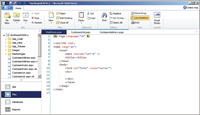Product Reviews
WebMatrix Review: Enable Power Users
WebMatrix may not have a place in your toolbox, but it probably does have a place in your organization -- and it's one you should foster.
If you belong to one of those organizations that keeps trying to stamp out software development by anyone but the IT department, then you don't need WebMatrix.
But if your organization has recognized that it's impossible to stop power users from building applications for themselves and their departments, then WebMatrix has a role to play. A tool like WebMatrix can be useful to you by enabling others -- for example, those power users -- to build applications that would otherwise have to go into your backlog.
Many power-user applications eventually come under the control of a professional developer when the application hits some level of complexity. The tool must support migration to the organization's "real" development platform. In addition, these applications must support some kind of robust deployment process that's simple enough for power users to work with, but reliable enough to meet company standards. WebMatrix meets those goals.
When WebMatrix starts up, the user is presented with a Quick Start page that provides four ways to initialize a site. The Web Gallery and Templates options allow the user to select from predefined sites. The Templates are surprisingly sparse (only five) but the Web Gallery has several dozen choices organized around various toolsets. The choice that's most useful for the power-user scenario creates a site from a folder. WebMatrix can open and work with ASP.NET Web sites. By providing a few basic start points (for example, with the company's Master Pages) you can control how users create their sites.

[Click on image for larger view.] |
| Figure 1. The UI for WebMatrix looks like Office across the top and Outlook down the left-hand side. Pieces of Visual Studio, like the Solution and Server Explorers, appear in those left-hand panels. |
The WebMatrix interface bogs down a bit, primarily because it integrates both a site-monitoring tool and a site-development tool. When WebMatrix first opens, users can find themselves dealing with the site-monitoring choices rather than getting to the menus that support their real goal: building a new site. Once users get up to speed with the interface, they'll find switching between tasks fast and easy.
Once past the initial UI, users have a product that lets them develop with the same building blocks that Visual Studio provides: ASPX pages. The deployment process uses the new Microsoft Web Deployment package, so if you've migrated to Visual Studio 2010, both you and your power users will be sending your Web master the same packages. Using the included version of IIS Express, WebMatrix applications can be run on departmental servers.
The question is whether your power users can deal with the complexity of creating ASP.NET sites. Developers can use HTML pages, but they can also add ASPX pages, Master Pages and code files. This isn't a tool with a lot of wizards that generate code for users -- they're going to have to write it themselves. By default, WebMatrix will encourage users to embed code inside their ASPX pages, but it also supports the code-behind model. The key point is that a site created in WebMatrix can be readily migrated to Visual Studio.
Installing WebMatrix is a breeze and could be reasonably left to a power user. The download not only installs WebMatrix, but also includes SQL Server Compact 4, the Web Deployment package and the new IIS Express 7.5.
Can the power users in your organization actually use WebMatrix? That's a tougher question to answer. Some training will be required, but if properly employed, WebMatrix gives power users the tools to create Web sites that your development organization can live with.
Microsoft WebMatrix
Microsoft
Web: Microsoft.com
Phone: 1-800-642-7676
Price: Free
Quick Facts: A tool that enables power users to create, customize and deploy Web sites
Pros: A simplified UI that incorporates Web development, deployment and site monitoring
Cons: No out-of-the-box support for generating pre-defined apps; users are expected to write their own HTML, ASPX tags and code
About the Author
Peter Vogel is a system architect and principal in PH&V Information Services. PH&V provides full-stack consulting from UX design through object modeling to database design. Peter tweets about his VSM columns with the hashtag #vogelarticles. His blog posts on user experience design can be found at http://blog.learningtree.com/tag/ui/.